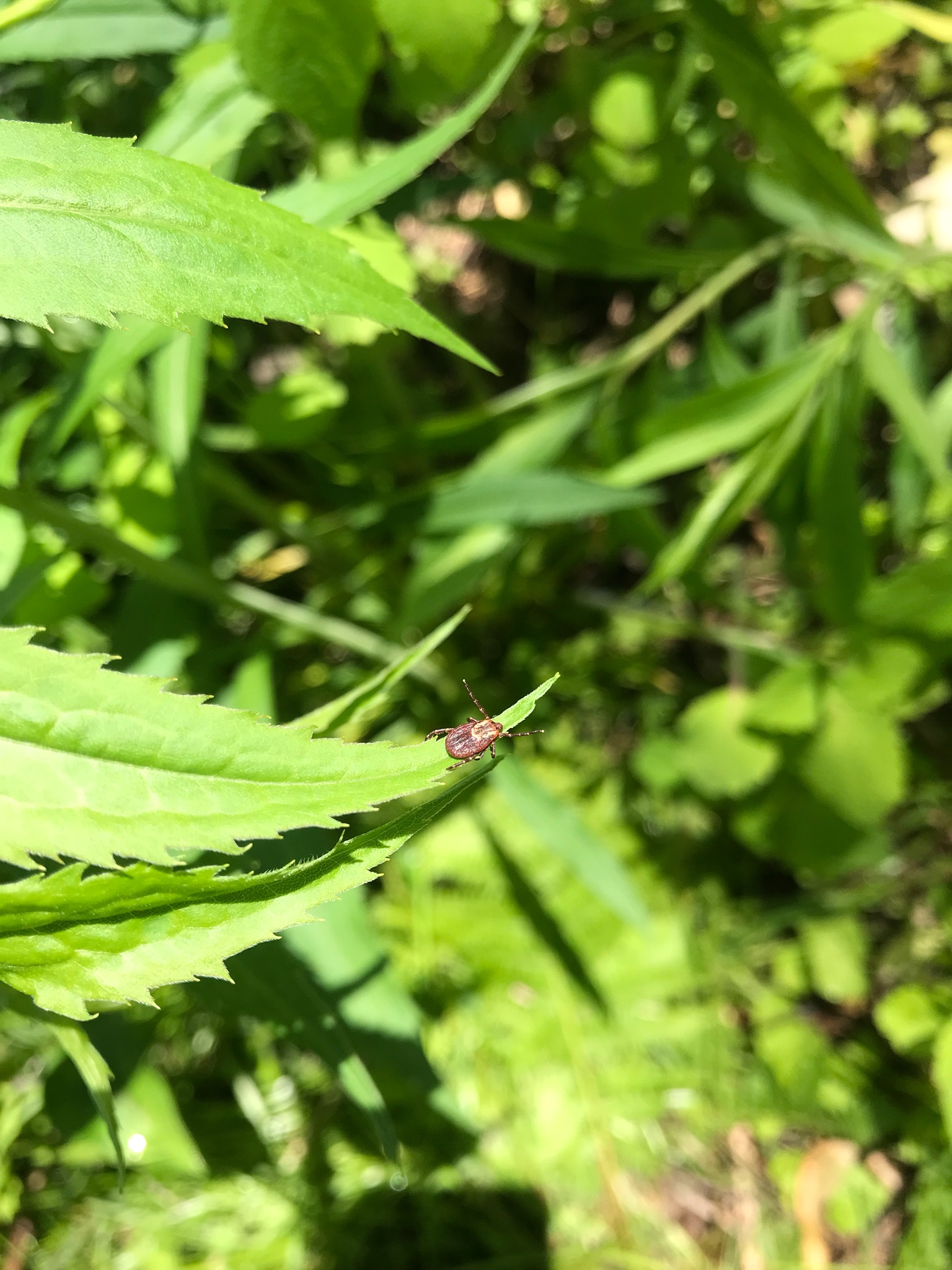Tick-borne illnesses do not only plague people. Our pets can also fall victim to very debilitating and sometimes deadly tick-borne pathogens. Being aware of the dangers and illnesses that ticks can cause should be noted for animals as well. We will be covering the most common pathogens found in ticks as well as commonly transmitted pathogens in the United States.
Lyme Disease: Borrelia burgdorferi the main causative agent for Lyme disease that can affect humans dogs, horses, and possibly cats. Although there are multiple strains that can cause Lyme disease, the majority of cases have been found to be caused by B. burgdorferi. Its main vector is the deer tick/black-legged tick (Ixodes scapularis, Ixodes pacificus). The Northeast, Upper Midwest, and Pacific coast have the highest cases of Lyme disease.
The clinical symptoms for Lyme disease include fever, loss of appetite, swollen joints, lethargy, and swollen lymph nodes. Sometimes symptoms may never occur, which is why Lyme disease can be a silent debilitating disease.
Diagnostics rely on clinical symptoms as well as laboratory testing.If your pet has had a recent tick bite with the symptoms previously listed your veterinarian might immediately put your pet on antibiotics, especially if you live in an area with a high index of Lyme disease. Normally testing will include PCR, ELISA, and serological testing that should be done 4-6 weeks after the initial tick bite to eliminate a chance of false negatives occurring.
Treatment for Lyme disease is at least four weeks of doxycycline due to B. burgdorferi’s latent and resistant nature. If you are concerned about your dog or horse contracting Lyme disease, vaccination is an option that many veterinarians offer.
Ehrlichiosis: Ehrlichia canis is a bacteria that is primarily carried by the brown dog tick (Rhipicephalus sanguineus). E. canis is endemic to southeastern and southwestern parts of the United States.
The clinical signs of ehrlichiosis are separated into three stages:
- Acute (early disease) – In this stage, infected dogs might experience fever, swollen lymph nodes, respiratory issues, weight loss, bleeding disorders. This stage can last ~2-4 weeks. Dogs can recover naturally from this stage, otherwise, they will head into the next phase of the infection.
- Sub-clinical – Although the dog is experiencing an active infection, they may not show any symptoms during this stage. Unless laboratory diagnostics are performed there is little to go off during this time. Again, the dog may be able to overcome the infection. If not, they enter the last stage.
- Clinical Ehrlichiosis – If the dogs immune system fails during the previous two stages to eliminate the infection they are left with a wide range of symptoms. The most commonly seen symptoms are unexpected bleeding, anemia, lethargy, swollen limbs, blindness, and neurological issues
For laboratory diagnostics standard PCR or ELISA testing is recommended at least 4-6 weeks later than the initial tick bite occurred. Blood tests including a complete blood cell count are recommended since anemia and spontaneous bleeding are symptoms. German Shepherds, Doberman Pinschers, Belgian Malinois, and Siberian Huskies seem to have more severe manifestations of an ehrlichiosis infection.
Doxycycline is normally given as an effective treatment for most tick-borne illnesses, including Ehrlichiosis. It is recommended that a four week course be given, but this will be up to your veterinarian to decide.
Rocky Mountain Spotted Fever: Rickettsia rickettsii may cause several diseases, but the most common being RMSF. The bacteria can affect humans as well as dogs. The primary vector of R.rickettsii is the American dog tick (Dermacentor variabilis). American dog ticks as a vector are quite dangerous as they often feed on humans and dogs. They are also quick to change their geographic locations, this might be due to climate change.
The clinical signs of RMSF are especially debilitating to dogs. They include fever within a few days from exposure of the tick bite, skin rash, edema of limbs, myalgia, and neurological issues.
Diagnostic testing for RMSF relies heavily on serological results as it is the most common method used by veterinarians. Indirect fluorescent antibody assay (IFA) and ELISA are most commonly used. Thrombocytopenia is a hallmark of rickettsial infections, therefore it would be wise to have a blood count performed if RMSF is suspected.
Doxycycline is the main treatment for canine and human rickettsial infections. The recommended course would be 4 weeks. Sometimes corticosteroids can be given to dogs to help with the intense inflammation they experience during the infection.
Anaplasmosis: Anaplasma phagocytophilum or Anaplasma platys. A. phagocytophilum affects humans, dogs, cats, and horses. Its main vector is the black-legged and western black-legged ticks (Ixodes scapularis/Ixodes pacificus). A. platys affects dogs and is carried by the brown dog tick (Rhipicephalus sanguineus). Anaplasma has a very high index in the Northeast and the Upper Midwest.
The clinical signs of anaplasmosis in dogs are joint pain, limping, lethargy, fever, vomiting, loss of appetite and anemia. Thrombocytopenia can occur due to the infection targeting blood platelets.
Diagnostics include PCR, ELISA, and IFA. Blood smears and a complete count should also be performed to rule out anemia and thrombocytopenia.
Treatment for canine anaplasmosis relies on doxycycline. The normal length of antibiotics would be 2-4 weeks depending on clinical signs/laboratory results. Sometimes doxycycline is also combined with the main treatment to eliminate any co-infections.
Babesiosis: Babesia canis is very different from the other illnesses mentioned above. It is a protozoan infection instead of a bacterial infection. Protozoa have complex life-cycles and mimic human cells which makes them quite difficult to treat and cure. Babesiosis can be transmitted multiple ways; blood transfusions, transplacental transmission, and of course through tick bites which is the most common transmission route.
Clinical symptoms include lethargy, reduced appetite, pale gums (due to anemia) and weakness. Diagnostics rely on PCR, ELISA, and serological testing – complete blood count to rule out thrombocytopenia. Certain dog breeds including Terriers, and Greyhounds are at an increased risk of infection.
Treatment is a combination of specific antiprotozoal/antiparasitic antibiotics of azithromycin and atovaquone. Blood transfusions may be needed in some dogs with severe anemia. The length of treatment should be determined by your veterinarian based on the severity of symptoms. Traditionally, ten days is the recommended time frame.
Hepatozoonosis: Hepatozoon canis is a protozoan parasite carried by the brown dog tick R. sanguineus. The parasite affects carnivores such as dogs, foxes, jackals, hyenas, and many more. The mode of transmission differs vastly from the usual tick bite. Instead, dogs ingest the infected tick and obtain the parasite through digestion. Hepatozoonosis has been reported in several states including Texas, Alabama, Mississippi, Georgia, Oklahoma, Tennessee, and Florida.
Clinical symptoms are fever, lethargy, anorexia, and muscle wasting. Since H. canis reproduce in the organs associated with blood storage like the spleen and bone marrow your dog may become sick quite quickly.
Diagnostics should heavily rely on blood smears and complete blood counts as they are found in the neutrophils and monocytes. Leukocytosis (increased white blood cells) is seen in numerous cases as well as elevated ALP activity (marker of bone disorder).
Treatment for hepatozoonosis in dogs requires a dose of imidocarb dipropionate every 14 days or until parasites are no longer shown on blood smears. Sometimes completely eliminating the parasite is difficult and a low amount of them are sufficient for normal function. Without proper treatment a dog may die within 12 months of infection.

